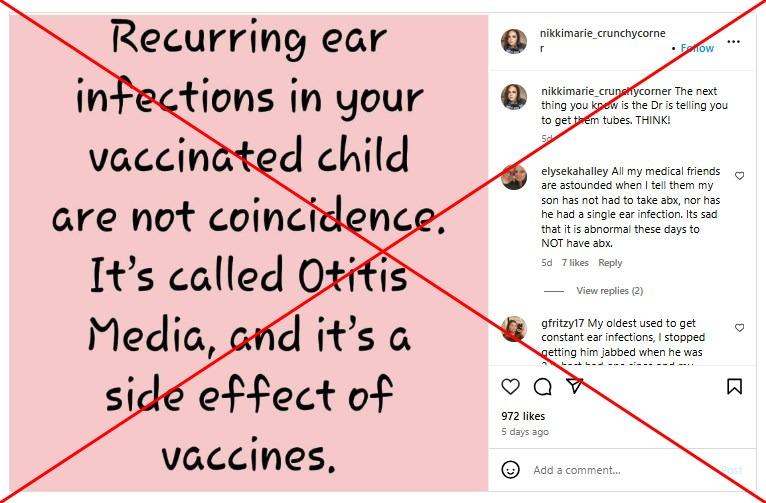
No evidence linking chronic ear infections to vaccination
- This article is more than one year old.
- Published on December 10, 2024 at 21:26
- 3 min read
- By Marisha GOLDHAMER, AFP USA
"Recurring ear infections in your vaccinated child are not coincidence. It's called Otitis Media, and it's a side effect of vaccines," a November 27, 2024 Instagram post reads.
The same claim has circulated on Facebook since at least 2018, in posts questioning the benefits of routine childhood vaccines as well as the need for tubes to treat chronic ear infections. Similar claims can be found on X. None link to research backing the contentions made.

The posts are the latest manifestation of vaccine hesitancy, often fueled by misinformation.
Otitis media or a middle ear infection, is the most common type of ear infection (archived here).
The National Institutes of Health reports "five out of six children will have at least one ear infection by their third birthday (archived here). But there is "no good evidence" linking vaccines to increased risk of ear infection, said Nathan Boonstra, general pediatrician at Blank Children's Hospital (archived here).
"In fact, the opposite is true," he said, pointing to the success of the Haemophilus influenzae type b (Hib) vaccination and the pneumococcal vaccines in reducing infections by bacteria and the annual influenza shot which reduces the risk of viral infections that can lead to secondary ear infections.
"We've seen over the decades that ear infections in young children have decreased while these vaccines have been added to the schedule," Boonstra said in a December 6 email.
In contrast to the online skepticism, a 2024 study led by the World Health Organization found "global immunization efforts have saved an estimated 154 million lives -- equivalent to almost six lives every minute of every year -- over the past 50 years" (archived here).
Additionally, a 2011 study in Germany specifically looking at infections in more than 17,000 children and adolescents did not find the prevalence depended on vaccination status. (archived here).
What causes ear infections?
Ear infections are commonly caused by the bacterium streptococcus pneumoniae (archived here).
Children are more prone to such infections because their immune systems are still developing and in part because their eustachian tubes -- connecting the middle ear to the back of the throat -- are smaller, making it difficult for fluid to drain from the ear (archived here and here).
Most ear infections occur when a child has a respiratory illness. "Colds cause congestion in the middle ear space and make it more likely that bacteria can grow, causing the infection," Boonstra said.
Daily exposure to germs in day care or school settings can increase the risk (archived here).
Children exposed to secondhand smoke are also at higher risk of infection (archived here).
Bottle feeding in bed has been linked to ear infections, while breastfeeding has been shown to reduce the risk in early childhood (archived here and here).
Ear infection treatments
There are effective home remedies for ear infections, including using a warm compress to alleviate pain and applying garlic oil which is antimicrobial (archived here). If the child's symptoms do not improve after 48 hours, a doctor may prescribe antibiotics (archived here).
The American Academy of Pediatrics does not recommend prescribing prophylactic antibiotics to reduce the frequency of chronic infections (archived here). For recurring infections -- three or more within six months -- a patient may be recommended tympanostomy tubes which are inserted via a surgery (archived here). It is the most commonly performed surgery on children in the United States, with some half a million procedures each year (archived here).
"The main reason for placing ear tubes is to help preserve the child's hearing," Boonstra said. "Kids who have had a lot of ear infections, or ones that last a long time are at increased risk of problems with hearing during important years of language development."
Most children recover from the surgery within a day and the ear tubes generally fall out on their own six to 18 months after the procedure (archived here).
More of AFP's reporting on vaccine misinformation is available here.
Copyright © AFP 2017-2025. Any commercial use of this content requires a subscription. Click here to find out more.
Is there content that you would like AFP to fact-check? Get in touch.
Contact us




